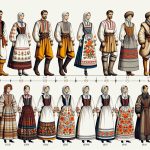
The Solidarity movement started in Poland in the early 1980s and played a huge role in fighting against authoritarian rule, pushing the country towards democracy. Led by Lech Wałęsa and others, this trade union became more than just about labor issues; it turned into a political force that stood up to the government.
This movement got attention worldwide and received support from different places. Let’s dive into how it began, the government’s reaction to it, and the lasting effects it has had on Poland and beyond.
It’s interesting to see how the legacy of Solidarity still matters today and what we can learn from it in our current social and political environment.
The Birth of Solidarity
In August 1980, the Solidarity movement burst onto the scene in Poland, starting at the Gdańsk Shipyard. This wasn’t just about workers fighting for better conditions; it was a massive push against the communist government’s way of doing things. People were fed up with how the government was handling the economy and their freedom, or lack thereof. Solidarity wasn’t just another union. It became a symbol for a bigger struggle – a fight for real change in a place where speaking out could land you in serious trouble.
The movement kicked off because of economic struggles and the government’s tight grip on power. Imagine working hard every day and still struggling to make ends meet, while also having no say in how things are run. That was the reality in Poland back then. Solidarity’s approach was different. They chose non-violent resistance, which was a bold move. Instead of just fighting for better pay, they sparked conversations about freedom, human rights, and how the country should be governed. This wasn’t just about making life better for workers; it was about reshaping the entire society.
Solidarity’s impact was huge. It showed that when people come together, they can challenge even the most powerful authorities. It wasn’t an easy path, and there were plenty of obstacles along the way, but the movement’s spirit and the drive for change were unstoppable. By standing firm and demanding respect for human rights and democracy, Solidarity laid the groundwork for a new Poland. This wasn’t just a moment in history; it was the start of a journey toward freedom and democracy in a place where such ideas had been suppressed for too long.
Key Figures and Roles
Several key individuals played crucial roles in the development and success of the Solidarity movement, contributing their unique perspectives and leadership qualities. Lech Wałęsa, an electrician from Gdańsk, stood out as the movement’s charismatic leader. His practical approach and ability to connect with people made him a central figure. Wałęsa’s efforts were internationally recognized when he received the Nobel Peace Prize, highlighting his significant impact on the movement.
Intellectuals like Jacek Kuroń and Adam Michnik added depth to Solidarity, combining the fight for workers’ rights with broader demands for social justice and democracy. Their writings and activism provided the movement with a strong moral and intellectual foundation. This approach ensured that Solidarity was not just a labor protest but a comprehensive effort for systemic change, deeply connected to Polish history and identity.
Government Response
In facing the rising Solidarity movement, the Polish government was initially surprised but quickly adopted a strategy that combined talks, legal restrictions, and force to manage the situation. The government started negotiations with the leaders of Solidarity, hoping to calm the movement. At the same time, they introduced strict laws and censorship to weaken its support. This approach showed the government’s difficulty in keeping control while trying to avoid further protests.
The most intense action taken by the government was declaring martial law in December 1981. This move led to arrests, detentions, and a severe limit on the activities of the Solidarity movement. It was a clear display of the government’s intent to suppress any opposition. However, this also highlighted the challenge of dealing with a widely supported movement. The government had to balance its actions to prevent alienating the public and attracting negative attention from the international community.
Let’s break down these events a bit more. When the government talked with Solidarity leaders, it was a step toward understanding the demands of the movement. However, by simultaneously enforcing strict laws and censorship, the government showed it wasn’t fully open to change. This contradiction made the situation more complex.
The declaration of martial law was a drastic measure. It included a curfew, restricted movements, and a significant military presence in cities. Imagine living in a place where you couldn’t leave your house at certain times or freely express your opinions. This was the reality for many Poles during this period.
Despite these harsh measures, the Solidarity movement continued to gather support, showing the resilience of the Polish people. The government’s actions, while intended to suppress the movement, actually demonstrated the power and determination of those fighting for their rights. This period in Polish history is a testament to the struggle for freedom and the complexities of political power.
Global Impact and Support
Solidarity’s efforts in advocating for freedom and justice significantly changed the political scene in Poland and caught the attention of the international community. This movement against oppression showcased the effectiveness of peaceful, community-driven initiatives. It set an example for civil rights movements around the world, demonstrating the strength found in unity. Support came from many Western countries, especially from labor unions and human rights groups, which offered financial help and raised their voices in solidarity. This global support network put pressure on Poland’s government and its allies in the Soviet Union, underlining how political movements are interconnected across borders.
The success of Solidarity inspired activists in other countries under Soviet control, signaling the start of a shift in the region. This ripple effect was a clear message of the widespread longing for freedom and democratic governance. For example, the financial and moral support from international partners not only boosted Solidarity’s efforts but also shone a spotlight on the importance of global solidarity in fighting authoritarianism. This kind of international collaboration can be seen in other contexts as well, such as global initiatives for climate change or humanitarian aid, where pooling resources and knowledge from around the world leads to more effective solutions.
In a straightforward manner, Solidarity’s journey from a local movement to a global symbol of resistance against oppression illustrates the power of collective action and international support in achieving significant political change. It’s a reminder that in our interconnected world, the fight for justice in one place can inspire and impact broader global movements. This story encourages us to support each other across borders, understanding that our shared efforts can lead to meaningful change.
Legacy and Modern Influence
The Solidarity movement in Poland has left a lasting mark on how people fight for political and social change today. Born in the 1980s, this movement stood up to Communist rule without using violence. Instead, they focused on bringing people together, especially workers, to demand their rights. This approach of organizing from the ground up and focusing on civil and worker rights has inspired many activists around the world.
In our current era, we see the influence of Solidarity in movements that gather wide support, use social media to spread their message, and push for human rights and democracy. For example, the Arab Spring and the global climate change movements have used social media to organize protests and spread their message, much like Solidarity did with the tools available at the time.
Solidarity’s ability to negotiate with a government that didn’t want to listen is also a powerful lesson for today. It shows that even in tough situations, peaceful protest can lead to change. This is a beacon of hope for those challenging authoritarian governments now, proving that unity and peaceful action can indeed make a difference.
Moreover, Solidarity’s story is not just about politics; it’s a lesson in how to bring about change in any area of life. Whether it’s fighting for better work conditions, environmental protection, or social justice, the key is to bring people together, focus on a clear goal, and persistently push for that goal without resorting to violence.
In essence, the Solidarity movement teaches us the power of collective action and peaceful protest. Its legacy lives on, showing us that when people come together for a common cause, they can change the world. This is a powerful reminder in today’s world, where we face many complex challenges. Solidarity’s journey from a group of shipyard workers to a movement that changed the course of history is a testament to what can be achieved when we stand together.
Conclusion
The Solidarity movement in Poland did a lot more than just change things in its own country. It helped kickstart a movement against unfair government control all over Eastern Europe.
Today, its impact is still seen in how people fight for their rights and democracy. The fact that Solidarity could get so many people together to stand up against tough regimes shows how powerful it is when people work together for a big change.






Comments are closed.